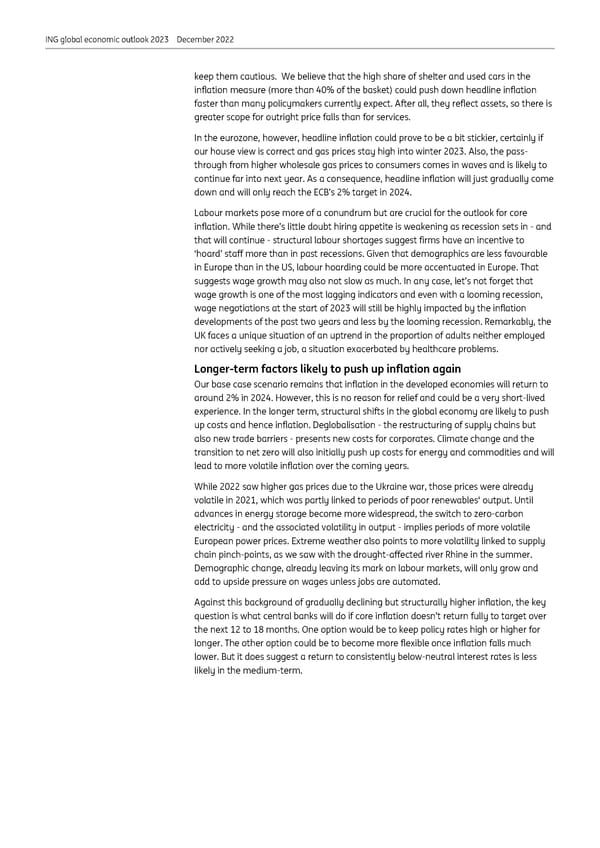ING global economic outlook 2023 December 2022 keep them cautious. We believe that the high share of shelter and used cars in the inflation measure (more than 40% of the basket) could push down headline inflation faster than many policymakers currently expect. After all, they reflect assets, so there is greater scope for outright price falls than for services. In the eurozone, however, headline inflation could prove to be a bit stickier, certainly if our house view is correct and gas prices stay high into winter 2023. Also, the pass- through from higher wholesale gas prices to consumers comes in waves and is likely to continue far into next year. As a consequence, headline inflation will just gradually come down and will only reach the ECB’s 2% target in 2024. Labour markets pose more of a conundrum but are crucial for the outlook for core inflation. While there’s little doubt hiring appetite is weakening as recession sets in - and that will continue - structural labour shortages suggest firms have an incentive to ‘hoard’ staff more than in past recessions. Given that demographics are less favourable in Europe than in the US, labour hoarding could be more accentuated in Europe. That suggests wage growth may also not slow as much. In any case, let’s not forget that wage growth is one of the most lagging indicators and even with a looming recession, wage negotiations at the start of 2023 will still be highly impacted by the inflation developments of the past two years and less by the looming recession. Remarkably, the UK faces a unique situation of an uptrend in the proportion of adults neither employed nor actively seeking a job, a situation exacerbated by healthcare problems. Longer-term factors likely to push up inflation again Our base case scenario remains that inflation in the developed economies will return to around 2% in 2024. However, this is no reason for relief and could be a very short-lived experience. In the longer term, structural shifts in the global economy are likely to push up costs and hence inflation. Deglobalisation - the restructuring of supply chains but also new trade barriers - presents new costs for corporates. Climate change and the transition to net zero will also initially push up costs for energy and commodities and will lead to more volatile inflation over the coming years. While 2022 saw higher gas prices due to the Ukraine war, those prices were already volatile in 2021, which was partly linked to periods of poor renewables' output. Until advances in energy storage become more widespread, the switch to zero-carbon electricity - and the associated volatility in output - implies periods of more volatile European power prices. Extreme weather also points to more volatility linked to supply chain pinch-points, as we saw with the drought-affected river Rhine in the summer. Demographic change, already leaving its mark on labour markets, will only grow and add to upside pressure on wages unless jobs are automated. Against this background of gradually declining but structurally higher inflation, the key question is what central banks will do if core inflation doesn’t return fully to target over the next 12 to 18 months. One option would be to keep policy rates high or higher for longer. The other option could be to become more flexible once inflation falls much lower. But it does suggest a return to consistently below-neutral interest rates is less likely in the medium-term.
 ING Global Economic Outlook 2023 Page 11 Page 13
ING Global Economic Outlook 2023 Page 11 Page 13